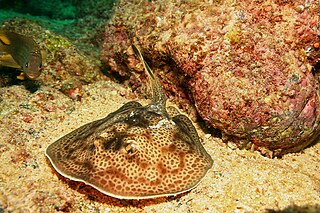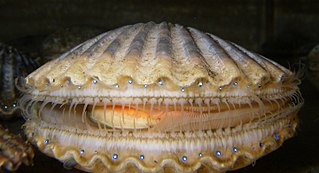Bullseye or Bull's Eye may refer to:

The Pluteaceae are a family of small to medium-sized mushrooms which have free gill attachment and pink spores. Members of Pluteaceae can be mistaken for members of Entolomataceae, but can be distinguished by the angled spores and attached gills of the Entolomataceae. The four genera in the Pluteaceae comprise the widely distributed Volvariella and Pluteus, the rare Chamaeota, and Volvopluteus, which was newly described in 2011 as a result of molecular analysis. The Dictionary of the Fungi estimates there are 364 species in the family.

Charniodiscus is an Ediacaran fossil that in life was probably a stationary filter feeder that lived anchored to a sandy sea bed. The organism had a holdfast, stalk and frond. The holdfast was bulbous shaped, and the stalk was flexible. The frond was segmented and had a pointed tip. There were two growth forms: one with a short stem and a wide frond, and another with a long stalk, elevating a smaller frond about 50 centimetres (20 in) above the holdfast. While the organism superficially resembles the sea pens (cnidaria), it is probably not a crown-group animal.

Leptolepis is an extinct genus of teleost fish that lived in freshwater and marine environments from the Middle Triassic period until the Early Cretaceous. The genus is one of the earliest recognized teleost genera.
Gundlachia is a genus of minute freshwater snails or limpets, aquatic pulmonate gastropod mollusks in the family Planorbidae, the ram's horn snails and their allies.

The bullseye round stingray, also known as the reticulated round ray, or spot-on-spot round ray, is a species of cartilaginous fish in the family Urotrygonidae. It is endemic to Mexico. Its natural habitats are shallow seas, subtidal aquatic beds, coral reefs, estuarine waters, intertidal marshes, and coastal saline lagoons. It is threatened by habitat loss.

Urobatis is a genus of the family Urotrygonidae. These rays live in Costa Rica, Mexico, the Bahamas, El Salvador, Honduras, Guatemala, Nicaragua, Colombia, Venezuela, Panama, Trinidad and Tobago, Barbados, Grenada, Saint Vincent and the Grenadines, Saint Lucia, Martinique, Dominica, Guadeloupe, Montserrat, Antigua and Barbuda, Belize, Puerto Rico, Saint Kitts and Nevis, Anguilla, Dominican Republic, Haiti, Jamaica, Cuba, Cayman Islands, Virgin Islands, Turks and Caicos Islands, French Guiana, Guyana, Suriname, Chile, Peru, Ecuador and the United States.

Chonetes is an extinct genus of brachiopods. It ranged from the Late Ordovician to the Middle Jurassic.

Argopecten irradians, formerly classified as Aequipecten irradians, common names Atlantic bay scallop or bay scallop, is a marine bivalve mollusk in the family Pectinidae, a species of scallop. An edible saltwater clam, it is native to the northwest Atlantic from Cape Cod to the Gulf of Mexico.
Scutomyces is a genus of fungi in the Ascomycota phylum. The relationship of this taxon to other taxa within the phylum is unknown, and it has not yet been placed with certainty into any class, order, or family. This is a monotypic genus, containing the single species Scutomyces concentricus.
Pirex is a fungal genus in the family Meruliaceae. It is a monotypic genus, containing the single crust fungus Pirex concentricus. It is found in the Pacific Northwest region of North America, where it causes a white rot in woody hardwood and conifer debris generated by timber harvesting.
Crassicheles is a genus of mites in the family Eviphididae. There are at least two described species in Crassicheles.

Spirifer is a genus of marine brachiopods belonging to the order Spiriferida and family Spiriferidae. Species belonging to the genus lived from the Middle Ordovician (Sandbian) through to the Middle Triassic (Carnian) with a global distribution. They were stationary epifaunal suspension feeders.
Uncancylus is a genus of small, freshwater, air-breathing limpets, aquatic pulmonate gastropod molluscs in the family Planorbidae, the ram's horn snails and their allies.

Actinoceramus is an extinct genus of fossil saltwater clams, marine pteriomorphian bivalve molluscs. These bivalves were facultatively mobile infaunal suspension feeders.
Uncancylus concentricus is a species of small, freshwater, air-breathing limpet, an aquatic pulmonate gastropod mollusc in the family Planorbidae, the ram's horn snails and their allies.
Uncancylus foncki is a species of small, freshwater, air-breathing limpet, an aquatic pulmonate gastropod mollusc in the family Planorbidae, the ram's horn snails and their allies.

Onychocerus is a Neotropical genus of beetles in the family Cerambycidae, containing the following species:
Onychocerus concentricus is a species of beetle in the family Cerambycidae. It was described by Bates in 1862.
Lentinus concentricus is a species of edible mushroom in the family Polyporaceae, first found in northern Thailand and described as new to science in 2011.









